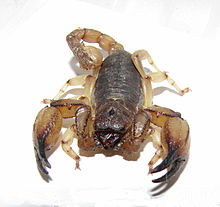
Scorpions are predatory arachnids of the order Scorpiones. They have eight legs and are easily recognized by a pair of grasping pincers and a narrow, segmented tail, often carried in a characteristic forward curve over the back and always ending with a stinger. The evolutionary history of scorpions goes back 435 million years. They mainly live in deserts but have adapted to a wide range of environmental conditions, and can be found on all continents except Antarctica. There are over 2,500 described species, with 22 extant (living) families recognized to date. Their taxonomy is being revised to account for 21st-century genomic studies.

The Buthidae are the largest family of scorpions, containing about 100 genera and 1339 species as of 2022. A few very large genera are known, but a high number of species-poor or monotypic ones also exist. New taxa are being described at a rate of several new species per year. They have a cosmopolitan distribution throughout tropical and subtropical environments worldwide. Together with four other families, the Buthidae make up the superfamily Buthoidea. The family was established by Carl Ludwig Koch in 1837.
Agoristenidae are a neotropical harvestman family of the Suborder Laniatores, in the superfamily Gonyleptoidea.
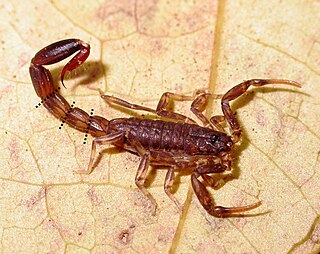
Ananteris is a little-known genus of rare scorpions. Scorpions belonging to the genus can be found from Costa Rica to Paraguay.
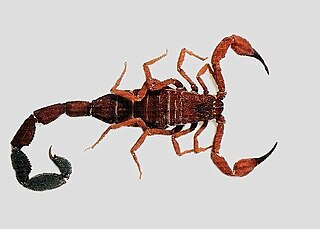
Tityus is a large genus of thick-tailed scorpions, the namesake of its subfamily Tityinae. As of 2021, Tityus contains more than 220 described species distributed in Central America and South America, from Costa Rica to Argentina. Species in the genus Tityus have been studied for hundreds of years, long before the taxonomic classification was put in place. Tityus tend to be of medium size for scorpions, roughly 50 to 70 millimeters long. They are dark brown or red in color, and can exhibit sexual dimorphism. They can live in a variety of environments, ranging from urban to arid mountains to the Amazon Rainforest. Tityus scorpions are best known for their venom and potent sting. The genus contains several dangerously venomous scorpions, the best known of which is the Brazilian yellow scorpion, T. serrulatus. Its venom can cause severe illness, and in the young, old and infirm even death. Some experts have argued that the genus as a whole may be paraphyletic, which could explain the knowledge gaps related to Tityus.

Hubbardiidae is a family of arachnids, superficially resembling spiders. It is the larger of the two extant families of the order, Schizomida, and is divided into two subfamilies. The family is based on the description published by Orator F. Cook in 1899. The American Arachnological Society assigns the common name hubbardiid shorttailed whipscorpion to members of this family.
The taxonomy of scorpions deals with the classification of this predatory arthropod into 13 extant families and about 1,400 described species and subspecies. In addition, 111 described taxa of extinct scorpions are known.

Vaejovidae is a family of scorpions, comprising 25 genera and 227 species, found in North America. The species of the genus are found in Mexico and the southern United States, and Paruroctonus boreus is found in Canada and is the northernmost species of scorpion in the world.
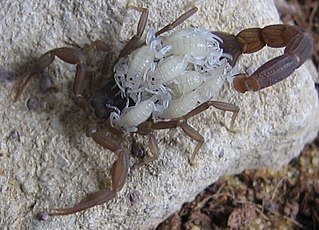
Compsobuthus is a genus of buthid scorpions.
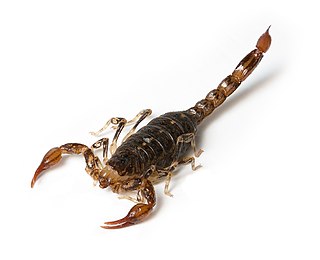
The Bothriuridae are a family of scorpions, comprising 151 species in 16 genera.

Scorpionidae is a family of burrowing scorpions or pale-legged scorpions in the superfamily Scorpionoidea. The family was established by Pierre André Latreille, 1802.

The Euscorpiidae are a family of scorpions.

Diplocentridae is a family of scorpions. The roughly 120 species are mostly native to the New World, except for genus Nebo, which is distributed in the Middle East.

Brachistosternus is a scorpion genus in the Bothriuridae family. B. ehrenbergii is the most cited species in the genus. The genus is distributed in Argentina, Bolivia, Brazil, Chile, Colombia, Ecuador, Paraguay, and Peru.

Opisthacanthus is a genus of scorpions in the family Hormuridae occurring in Central and South America, the Caribbean, Africa and Madagascar.
Wilson R. Lourenço is a French-Brazilian arachnologist specializing in scorpions.
Troglotayosicidae is a family of scorpions. The only genus in the family is Troglotayosicus.
Orthochirus is a genus of scorpion in the family Buthidae, first described by Ferdinand Karsch in 1891.
Charinus is a genus of amblypygids (whip-spiders) of the family Charinidae.
